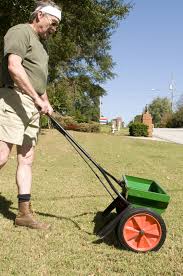Fertilizer Spreaders
If you find that you need to fertilize a large area of lawn then you will want to use a push type spreader. There are 2 types of spreaders: drop and rotary.
Drop spreaders
What you’ll find with drop spreaders is that they have an agitator that is the width of the hopper. Naturally what happens is that the fertilizer granules will drop straight down through the openings in the bottom of the spreader. You can adjust the openings in order to regulate fertilizer flow. Be sure to look at the label of the fertilizer package for proper application rates.

Drop spreaders are far more tricky than broadcast spreaders. This is because they deliver product directly beneath the hopper. You have to be accurate.
It is important that you slightly overlap each one of the applications to avoid striping your lawn. Be absolutely sure that you turn off the spreader when stopping or making turns.
In order to help with the accuracy, drop spreaders are low to the ground and might be more difficult to push than a rotary spreader.
You may also find that they skip every now and again. Despite that negative, they provide a definite application. They work wonderfully for sidewalks, gardens, smaller lawns, and swimming pools.
Broadcast and rotary spreaders
Broadcast spreaders are also known as rotary spreaders. How they work is they drop the fertilizer from the hopper onto a rotating disk that propels the granules outward. These types of spreaders are the best for large areas that require fertilizing.
Naturally, you’ll need to clean up any overspray when using these types of spreaders. This is because some fertilizer formulations can stain surfaces. As mentioned in the previous article, excess fertilizer will wash into a storm sewer and cause pollution.
How to spread fertilizer
If you happen to catch one of your local lawn care experts at a property, you’ll see that they walk at a casual, even pace. They can be seen either type of spreader.
Be careful to never pull a spreader backward. It is often an easy thing to do because there are numerous times it seems to be the way to go. Refuse to do that. The reason is, either type of spreader will apply far more fertilizer when pulled. This often leads to burning the grass and you almost always see a lawn or two in your neighbourhood that has done this.
How to apply liquid fertilizers
The third means in which to apply fertilizer is as a liquid. Liquid fertilizer applicators include hose-end sprayers which are the most common. You will also find injectors.
When using a hose-end sprayer, you place liquid or soluble fertilizer in the sprayers container. As water flows through the sprayer it mixes with water at a set application rate (the product will either have fixed or will tell you what rate to set it at).
When it comes to injector applicators, they are different in that they allow you to apply fertilizer through
The injector is attached to the faucet and a flexible siphon tube is placed in a bucket of concentrated liquid fertilizer. The fertilizer is pulled up through the tube and mixed into the water.
In conclusion
You now have a great idea of how to apply fertilizer. There are advantages and disadvantages to all three. In order to ensure the best results, only wet the soil with fertilizer. Of the three, liquid fertilizers can produce dramatic results in very little time. However, the results are often short-lived, so choose how you apply fertilizer wisely.